The fastest cars in the world demonstrate record-breaking top speeds afforded by advanced engineering and aerodynamics. An alternate metric for ranking the fastest cars in the world is quick acceleration times. Nevertheless, proven and estimated top speeds stand out as the prominent metric for which the most advanced vehicles are measured. This metric provides holistic insight into the types of engines, fuel consumption, acceleration times, driving experiences, and design features manufacturers have implemented to break records and deliver raw speed at a premium.

The fastest cars in the world are hypercars, luxury vehicles that utilize advanced engineering to push the boundaries of automotive performance. They exhibit aerodynamic features that reduce drag and enhance agility, lightweight and narrow bodies to minimize weight, and powerful engines or powertrains that deliver impressive horsepower. Other features include swift acceleration times amounting to mere seconds as well as high fuel consumption rates that accommodate robust feats of agility.
Many of the fastest vehicles are track-oriented and exhibit manufacturer-estimated top speeds that may only be proven under careful observation and controlled environments. Others are street-legal vehicles that claim peak speeds achievable on a track or similar. Additionally, the driving experiences of these hypercars are oriented around speed and therefore, they forego certain comforts like spacious cabins. Manufacturers make up for the limited comforts through luxurious, bespoke interiors and digital implementations such as driving modes to personalize experiences.
The list below summarizes the top five fastest cars and their notable features.
- Koenigsegg Jesko Absolut (330 mph, 531 km/h): The Koenigsegg Jesko Absolut holds the title of the world’s fastest car with the potential to reach a top speed of 330 mph and above. The Absolut nets an acceleration rate of 0 to 100 km/h in 2.5 seconds and produces 1280 horsepower with a twin-turbocharged V8 engine.
- Bugatti Bolide (311 mph, 501 km/h): The Bugatti Bolide reaches an estimated top speed of 311 mph, accelerating from 0 to 100 km/h in just 2.2 seconds. The Bolide is track-only, prioritizing performance above practicality.
- Hennessey Venom F5 (311 mph, 501 km/h): The Hennessey Venom F5 is a sports car with a top speed of 311 mph and a 6.6-liter twin-turbo V8 engine. The Venom F5 focuses on both luxury and performance, providing agility wrapped in a bespoke body.
- SP Automotive Chaos (310 mph, 500 km/h): The SP Automotive Chaos is designed to achieve a top speed of 310 mph or more. The Chaos is split into variants, the Chaos Earth and the Chaos Zero Gravity with the latter achieving greater horsepower.
- Bugatti Chiron Super Sport 300+ (304 mph, 489 km/h): The Bugatti Chiron Super Sport 300+ is a variant of the Bugatti Chiron with a top speed of 304 mph and a quad-turbocharged W16 engine. The car’s aerodynamic enhancements contribute to its exceptional performance.
Below we review the fastest cars in the world (including gas, hybrid, and electric hypercars), their top speeds, acceleration times, engines, and more.
1. Koenigsegg Jesko Absolut (330 mph, 531 km/h)
The Koenigsegg Jesko Absolut is the fastest car in the world with a potential top speed of 330 mph (531 km/h), and a base top speed of 300 mph (483 km/h). The Jesko Absolut is the high-performance-focused variant of the Jesko and the twin of the track-focused Jesko Attack.

It boasts a twin-turbocharged V8 engine delivering 1280 horsepower at 7800 rpm, propelling it from 0 to 100 km/h in just 2.5 seconds. Aerodynamic features, including drag-reducing front underbody flaps and rear hood fins, contribute to its swiftness and prioritize performance over practicality. Efficiency and comfort are consequently secondary, and its theoretical capabilities are not achieved under normal driving conditions but are potentially possible under controlled circumstances.
2. Bugatti Bolide (311 mph, 501 km/h)
The Bugatti Bolide is among the fastest cars in the world with an estimated top speed of 311 mph (501 km/h). The car’s lightweight body redefines the limits of hypercar performance, being capable of an acceleration rate of 2.2 seconds from 0 to 100 km/h (62 mph). Furthermore, the Bolide is a track-only sports car which means that comfort, security, and efficiency are oriented toward maximizing performance. Its capabilities are inspired by LMP1 race cars, influencing cockpit design and suspension systems.
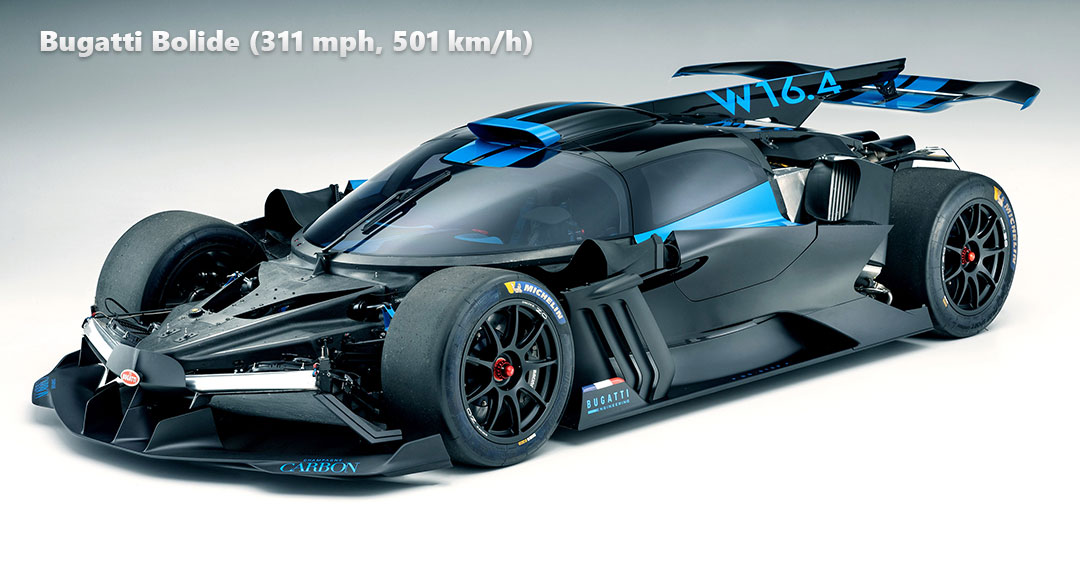
Details about fuel consumption warrant scrutiny as the Bolide’s concept focuses more on reaching new heights of performance and capability than on efficiency. The Bolide additionally features a quad-turbocharged 8.0L W16 engine like other Bugatti hypercars. However, it is the last model to do so according to an announcement from its makers in 2021, marking a pinnacle in the W16 legacy and cementing the Bolide as a high-speed marvel.
3. Hennessey Venom F5 (311 mph, 501 km/h)
The Hennessey Venom F5 is a limited-production American sports car with an estimated top speed of 311 mph (501 km/h). The Venom F5 features a 6.6-liter twin-turbo V8 engine, generating 1817bhp, designed for extreme speed. Hennessey set out to create the world’s fastest production car, and this goal is evident in its carbon fiber body and ultra-low drag coefficient. In addition to its superlative top speeds, Venom F5 boasts a lightning-fast acceleration time of 0-100 km/h (62 mph) in 2.6 seconds.
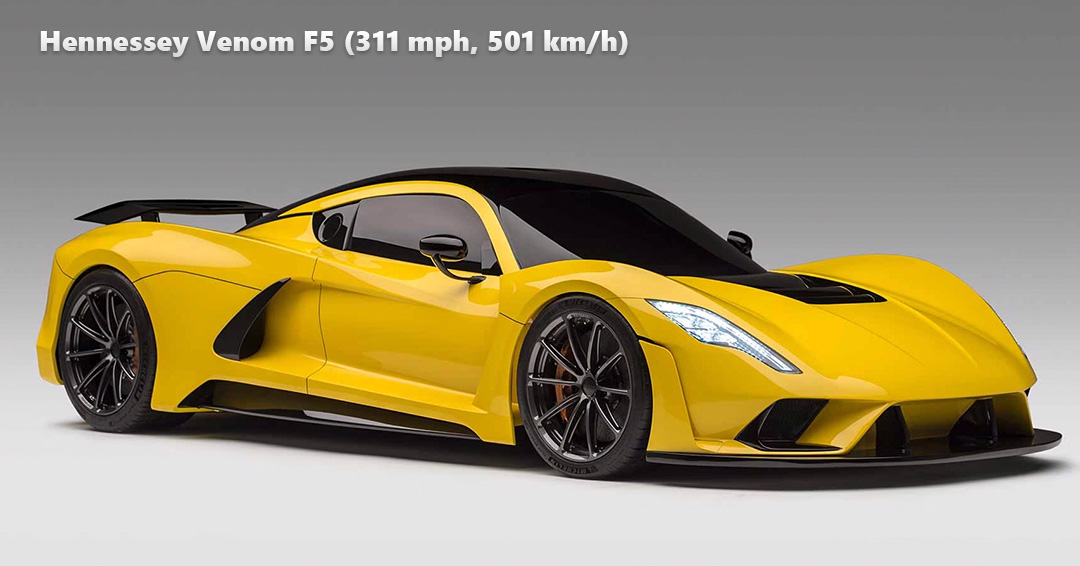
Decades of craftsmanship are additionally evident in the Venom F5’s meticulously designed interior. The creators at Hennessey capitalize on luxury elements such as accommodation for drivers of all sizes and accessory items—all without discounting the combined focus of both the driver and the car itself, which is agility.
4. SP Automotive Chaos (310 mph, 500 km/h)
The SP Automotive Chaos hypercar features an estimated top speed exceeding 310 mph (500 km/h). The Chaos is a project by Greek manufacturer, Spyros Panopoulos Automotive, with aims for record-breaking agility. It comes in two models: the baseline Chaos Earth model, and the more advanced Chaos Zero Gravity model. The Earth model accelerates from 0-100 km/h in approximately 1.9 seconds, while the Zero Gravity model achieves the same distance in 1.55 seconds. Both report a top speed of 310 mph.
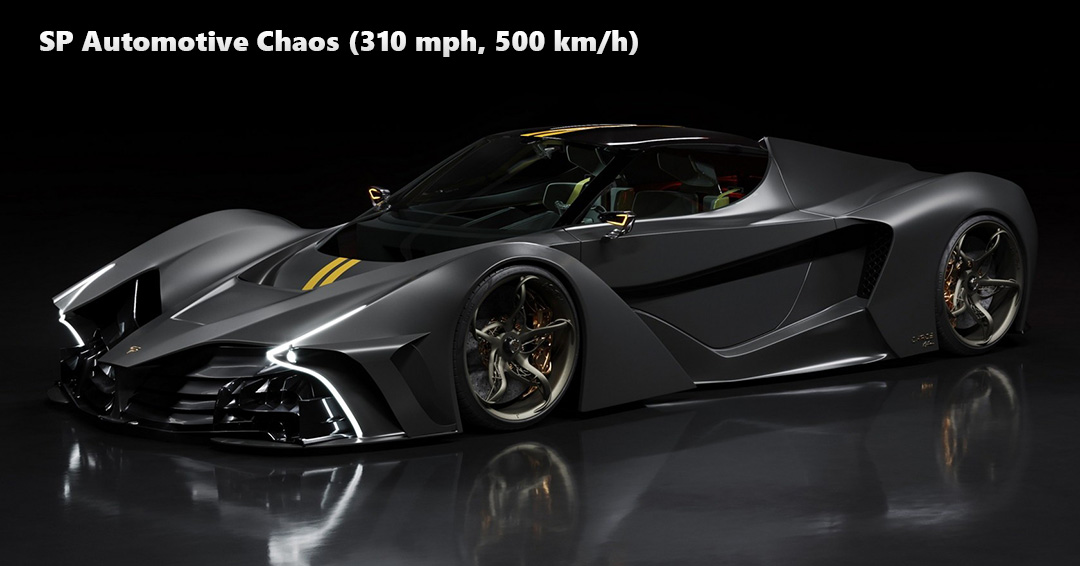
The Chaos houses a twin-turbocharged 4.0-liter V10 engine, reaching up to an estimated 2,048.7 hp (1527.7 kW) in the base model and a 3,064 hp (2284 kW) in the advanced Zero Gravity model. Additional notable features include 3D-printed magnesium wheels and brakes, which reflect a commitment to advanced technology designed to match the Chaos’ ambitions.
5. Bugatti Chiron Super Sport 300+ (304 mph, 489 km/h)
The Bugatti Chiron Super Sport 300+ is a hypercar variant of the Bugatti Chiron with a top speed of 304 mph (489 km/h). The 300+ tagline derives from the car’s speed which set a world record in August 2019. The car features an acceleration rate of 0 to 60 mph in 2.4 seconds, highlighting the superior capabilities of its quad-turbocharged W16 engine. This engine generates 600 PS (1,175 kW; 1,580 hp) coupled with a fuel consumption rate of 21.47 liters per 100 km (approximately 11 miles per U.S. gallon).
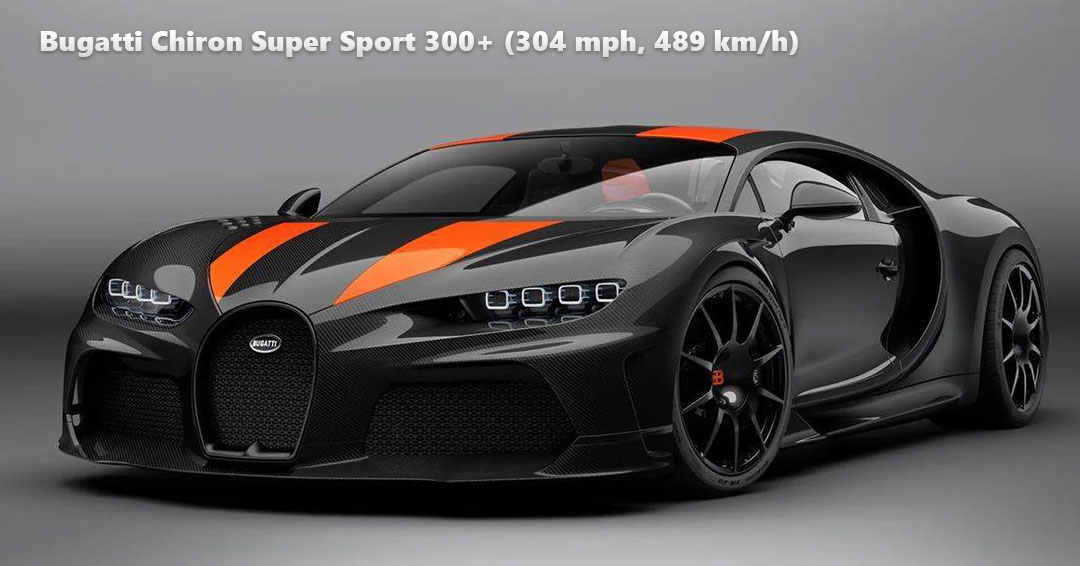
The Super Sport 300+ is aided by aerodynamic enhancements such as air curtains and extended body design to improve driving efficiency, pushing the boundaries of what was previously considered achievable in production cars. Meanwhile, its interior of black carbon, leather, and center console knee support provides comfort for the driver.
6. Koenigsegg Jesko (300 mph, 483 km/h)
The Koenigsegg Jesko is a street-legal sports car featuring an estimated top speed of 300 mph (483 km/h). The Jesko succeeds Koenigsegg’s Agera with two variants: the Jesko Absolut and Jesko Attack. The parent model of the Jesko focuses on performance, accelerating from 0 to 100 km/h in 2.5 seconds with the potential to exceed its determined top speed.
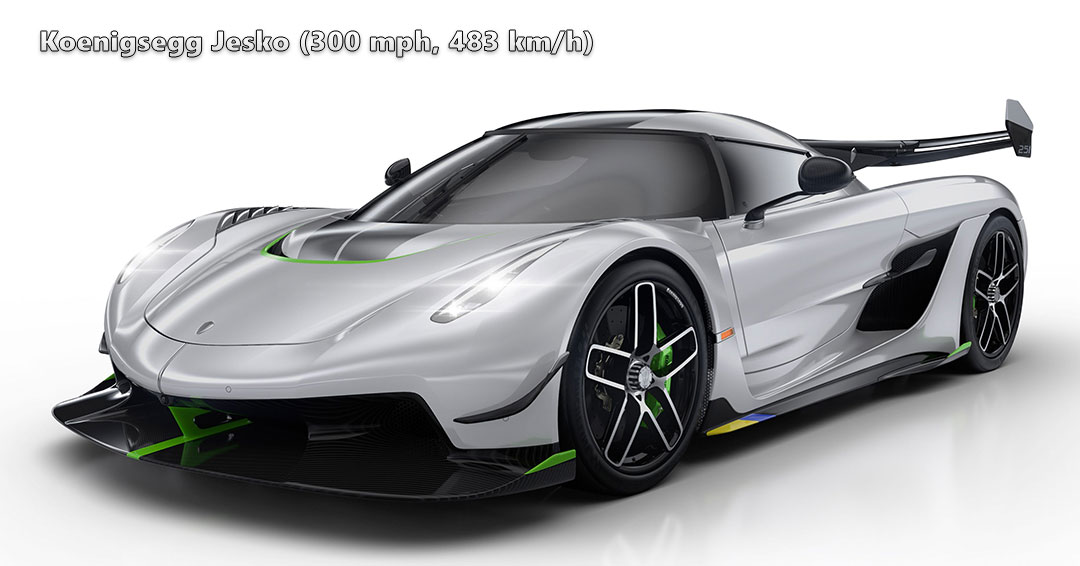
The Jesko’s features include rear hood fins, front underbody flaps, and active rear-wheel steering enhance maneuverability, enabling a secure and thrilling driving experience. Additionally, it features an upgraded twin-turbocharged V8 engine from the Agera, delivering an impressive 1,280 hp (1,298 PS; 954 kW) at 7,800 rpm. The Jesko’s speed, responsiveness, and power are further complemented by the Koenigsegg Engine Control Module, which enables dynamic adjustment of valve lift, duration, and timing to optimize performance in response to changing engine conditions.
7. SSC Tuatara (283 mph, 455 km/h)
The SSC Tuatara is a hypercar by SSC North America that achieved a top speed of around 283 mph (455 km/h) in 2021. The manufacturers initially claimed the Tuatara could reach as high as 331 mph (532 km/h), boosted by its twin-turbocharged V8. However, further testing proved that the Tuatara achieved a still-impressive peak of 283 mph (455 km/h). The Tuatara’s monstrous twin-turbo 5.9-liter engine produces 1,350 bhp, enabling 0-100 km/h (0-62 mph) acceleration in 2.7 seconds.
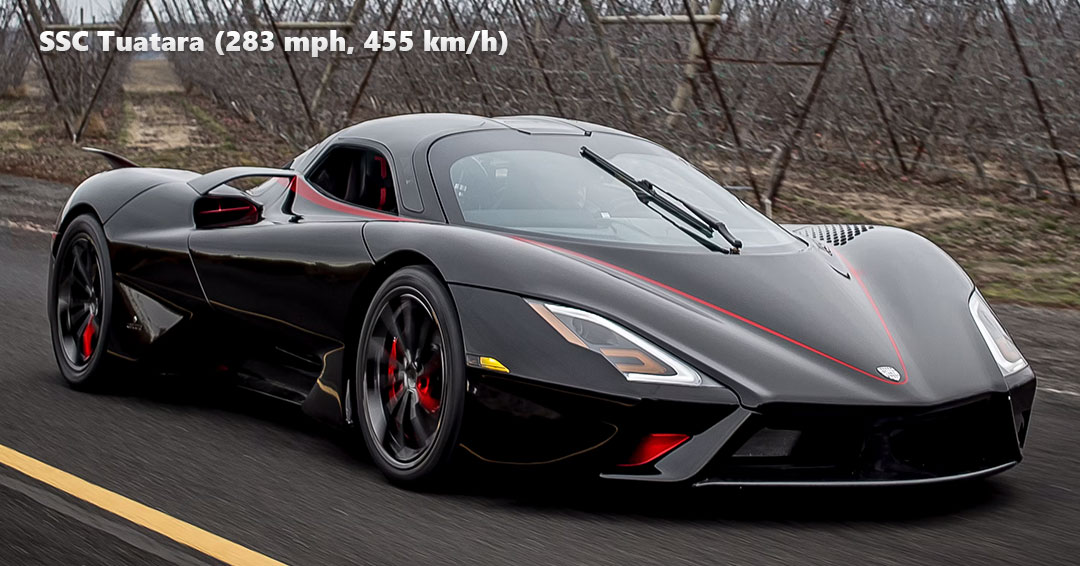
The rest of the Tuatara’s build similarly focuses on swift potential as the successor to the SSC Ultimate Aero, demonstrating a weight of 1,247 kg ( 2,750 lb) dry and production of 1,750 horsepower if fed E85 ethanol fuel.
8. Koenigsegg CC850 (280 mph, 451 km/h)
The Koenigsegg CC850 is a limited-edition sports car with an estimated top speed exceeding 280 mph (451 km/h). The CC850 was conceptualized as the spiritual successor of the CC8S, built in celebration of its 20th anniversary but featuring engineering rooted in the Koenigsegg Jesko.
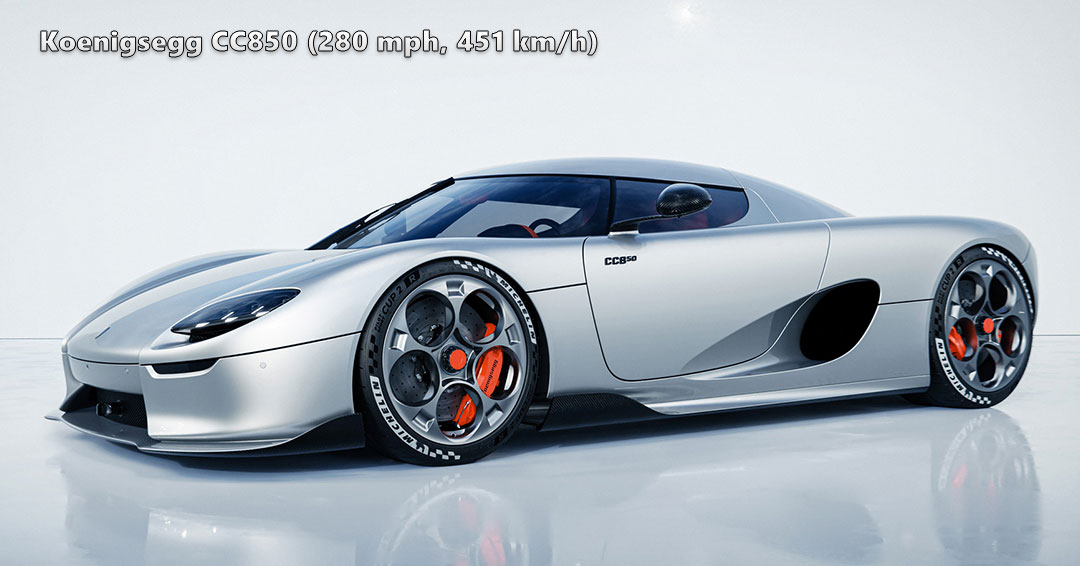
The CC850 shares the same the 5.0-liter Koenigsegg V-8 with the base Jesko, but with smaller turbochargers and multilink front and rear suspension. This engine generates 1,385 hp (1,404 PS; 1,033 kW) on E85, ensuring an adrenaline-pumping, high-speed experience. Agility is additionally backed by driving efficiency and handling. The CC850 offers the Engage Shifter System which simulates six gears of manual shifting. This allows drivers to gain a greater sense of control, enhancing the thrill of every acceleration.
9. Koenigsegg Agera RS (278 mph, 447 km/h)
The Koenigsegg Agera RS achieves a top speed of 278 mph (447 km/h) and was the world’s fastest production car in 2017. In addition to impressive top speed, the Agera RS clocks its acceleration at 2.8 seconds from 0-100 km/h (62mph). The Agera RS refines the concept of its predecessor the Agera R at 3000 lbs.
Contributing to the RS’s agility is an acceleration time of 2.8 seconds from 0 to 100 km/h (62 mph) and a lighter body than its predecessor, the Agera R, weighing in at 3000 lbs.
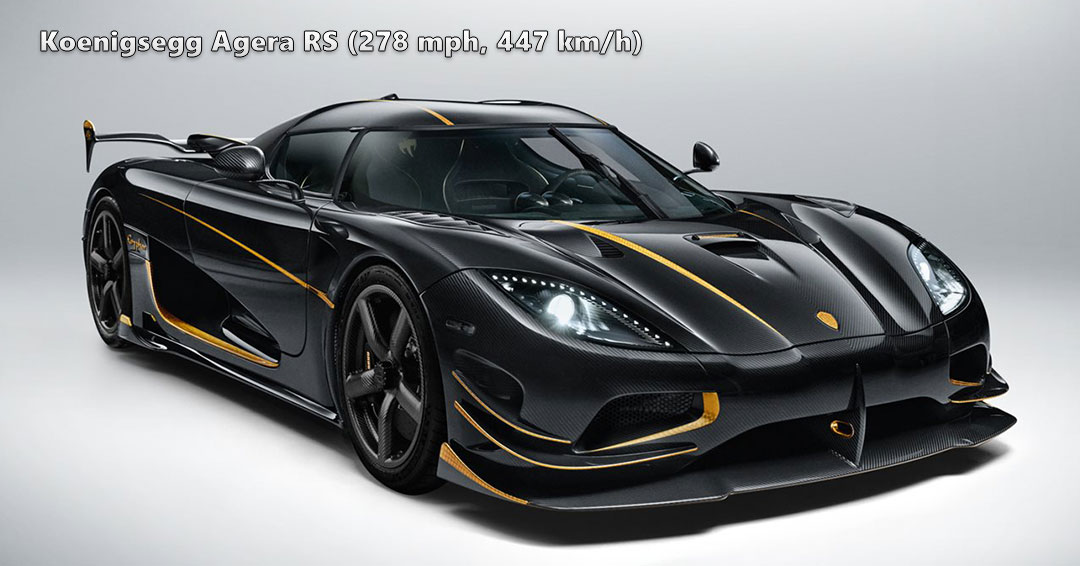
The Agera RS’s road tests as well as its driving comfort and efficiency are geared towards performance rather than everyday use. For example, the suspension maximizes power efficiency, providing the most for drivers interested in achieving distances faster. Adding to the Agera RS’s high performance is a twin-turbocharged V8 engine producing 1176 horsepower and 940 lb-ft of torque. Notably, its fuel consumption rate stands at 18 L/100 km (13 US mpg), reflecting its capabilities.
10. Bugatti Chiron Super Sport (273 mph, 440 km/h)
The Bugatti Chiron Super Sport is the 2021 standardized variant of the Super Sport 300+ and boasts a top speed of 273 mph (440 km/h). The Chiron Super Sport is less distinguished than the 300+ due to its capped capabilities. Even so, it remains one of the fastest cars on the market due to its combination of top speed and acceleration of 0 to 100 km/h (62 mph) in 2.4 seconds.
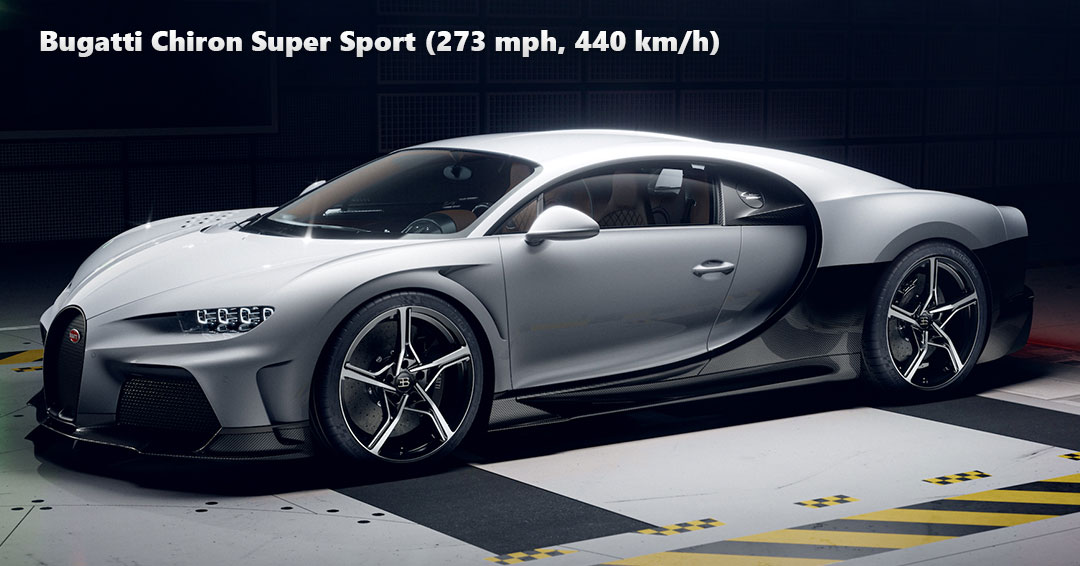
The Chiron Super Sport, like its successors the Super Sport 300+, has a quad-turbocharged 8.0 L W16 engine and a fuel consumption rate of 21.47 liters per 100 km. Driving comfort and security are oriented towards efficiency, a combination of longtail silhouette and guided airflow highlighting the aerodynamic focus of Bugatti’s design.
11. Bugatti Veyron Super Sport (268 mph, 431 km/h)
The Bugatti Veyron Super Sport is another iteration of Bugatti sports cars that features a top speed of 268 mph (431 km/h). The Veyron Super Sport is a variation of the base Bugatti Veyron (which has a top speed of 253 mph). The Super Sport edition is distinct from Veyron as it was one of the fastest production cars at the time of its creation in 2010, with an acceleration rate of 0 to 100 km/h in 2.8 seconds owed to its quad-turbocharged W16.
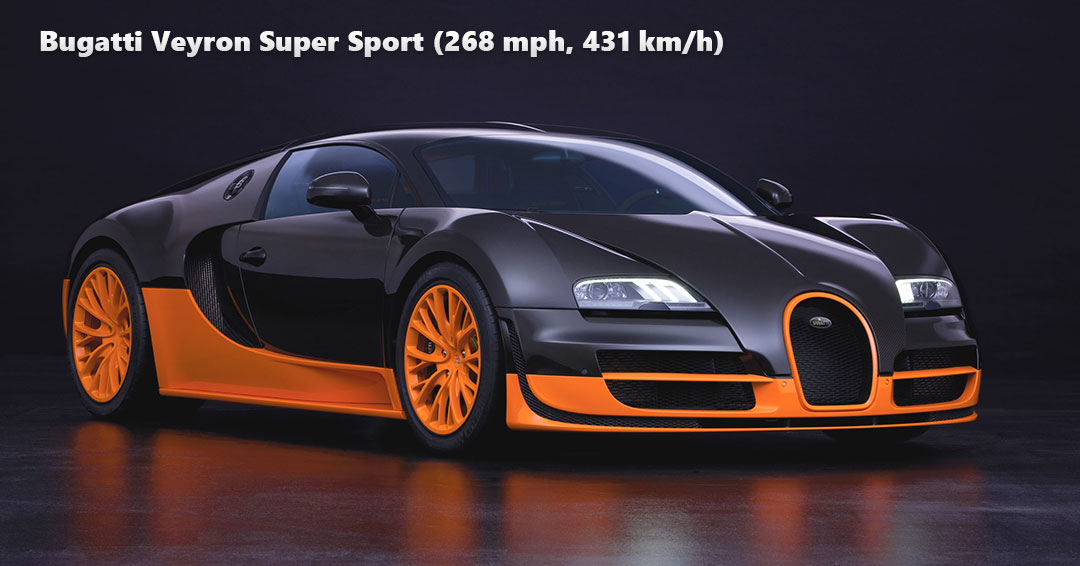
The Bugatti Veyron Super Sport exhibits generally low fuel efficiency owing to its high-performance design. For example, the combined fuel consumption rate is 23.1 liters per 100 km (10.18 US mpg). Road tests emphasize speed and stability, but everyday usage comes with pitfalls. Comfort is traded for forward motion and a firm suspicion makes it less efficient on difficult roads. Even so, the Bugatti Veyron Super Sport remains pivotal to automotive history by exemplifying the heights of luxury cars.
12. Zenvo TSR-GT (263 mph, 423 km/h)
The Zenvo TSR-GT is a hypercar from Danish manufacturer, Zenvo Automotive, with a top speed of 263 mph (423 km/h). It is a variant of the Zenvo TS1 GT, which succeeded the Zenvo ST1.
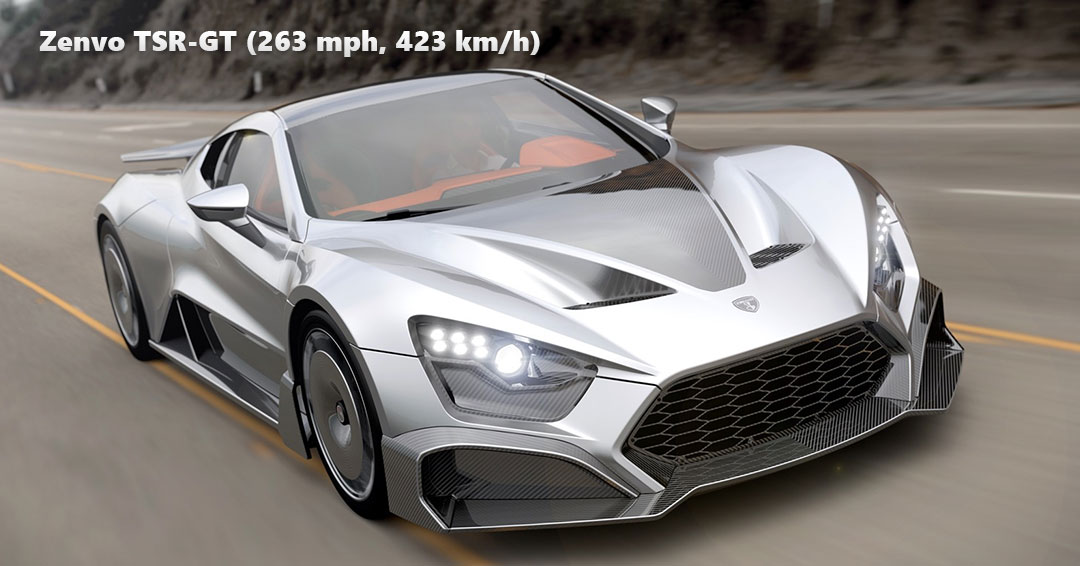
The TSR-GT employs upgrades on the TS1’s design to focus on long-distance, sophisticated driving experiences (otherwise known as grand touring from which the model gets its GT abbreviation). For instance, the twin-supercharged V8 engine was upgraded to 1,014 kW (1,360 hp), ensuring speed and responsiveness. The upgrade notably features a reduced downforce setup, incorporating a smaller, fixed wing and aerodynamic wheel covers. Other features include a paddle-shift seven-speed gearbox, an all-carbon fiber body, and interior modifications to reduce cabin noise.
13. Bugatti Mistral (261 mph, 420 km/h)
The Bugatti Mistral is a sports car with an estimated top speed of 261 mph (420 km/h). It features the potent 8.0-liter W16 engine from the Chiron Super Sport (which produces 1,578 hp). However, the Mistral achieves its higher peak velocity through the Top Speed mode, a model-specific directive that involves the rear wing automatically adjusting in order to minimize drag and improve performance. Bugatti limited its run of the Mistral to 99 units.

The Mistral’s agility is further enhanced by its distinctive aerodynamic body. The absence of a roof provides a unique driving experience that allows enthusiasts to embrace high speeds and winds in equal measure. Other aspects, such as bespoke luxurious interiors and large air intakes behind occupants’ heads, illustrate Mistral’s prospects in Bugatti’s collection of exclusive, high-performing vehicles.
14. Rimac Nevera (258 mph, 415 km/h)
The Rimac Nevera is an all-electric Croatian hypercar boasting an estimated top speed of 258 mph (415 km/h). The car claimed the title of the fastest electric car in the world in 2022 after nearly reaching a top speed of 256 mph (412 km/h). It additionally achieved an acceleration of 0–100 km/h (62 mph) in just 1.82 seconds thanks to its four liquid-cooled motor electric powertrain. However, everyday top speeds are limited to 219 mph.
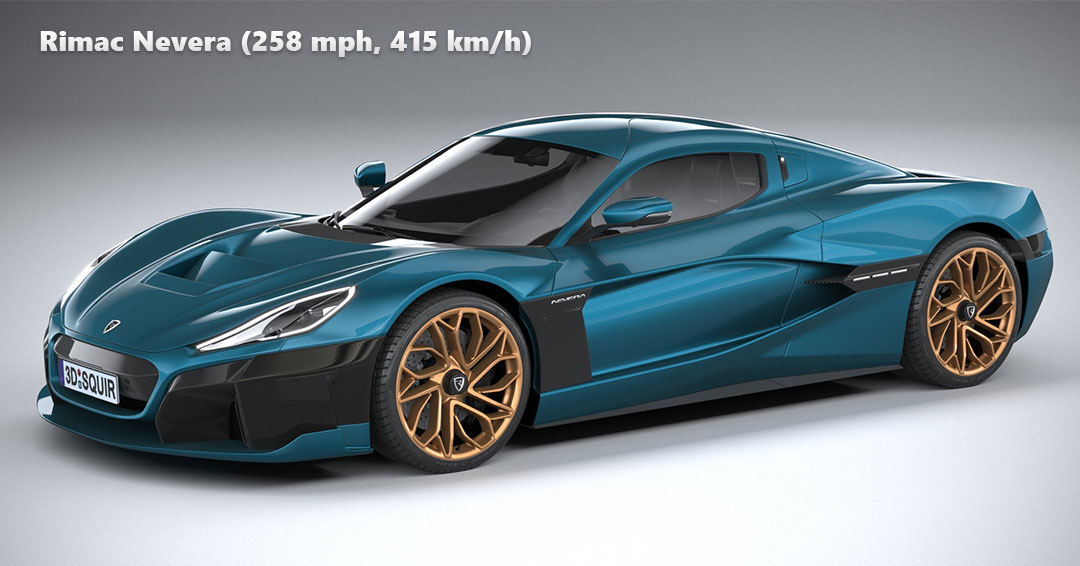
The Nevera’s road tests emphasize electric capability and handling, while the customizable aesthetics of the 150 units are centered on performance comfort, demonstrating a carbon monocoque with bare carbon fiber features. Drivers should note that the safety aspect is lacking in common driver-assistance features, prioritizing velocity over utility.
15. McLaren Speedtail (250 mph, 402 km/h)
The McLaren Speedtail is a noteworthy hybrid car prioritizing capability through its estimated top speed of 250 mph (402 km/h). The Speedtail is additionally distinct among our selections because of its exterior design and central driving position, both of which highlight the manufacturer’s commitment to maximum velocity.

The central driving position allows for enhanced visibility, balanced handling at high speeds, and optimized aerodynamics. Meanwhile, the exterior features an elongated tail that reduces shutlines and a body that enables uninterrupted airflow. McLaren further prioritizes high-speed stability through the incorporation of Velocity mode—capitalizing on the car’s dry weight of 1,499kg (3,305lbs) and powertrain for maximum speed and an acceleration time of 3.0 seconds across 0-100 km/h. The hybrid powertrain features a twin-turbocharged V8 and a parallel hybrid system motor. It attains 1070PS (1036bhp), showcasing advanced speed engineering and achieving a fuel consumption rate of 16 liters per 100 km (15 US mpg).
16. Aston Martin Valkyrie (250 mph, 402 km/h)
The Aston Martin Valkyrie exhibits a top speed of 250 mph (402 km/h) as a product of an Aston Martin and Red Bull Racing collaboration. The original Valkyrie was unveiled in 2017, but it is the 2022 production model that demonstrates the high points of the Valkyrie run, netting a 0-100 km/h acceleration of 2.6 seconds alongside its top speed.
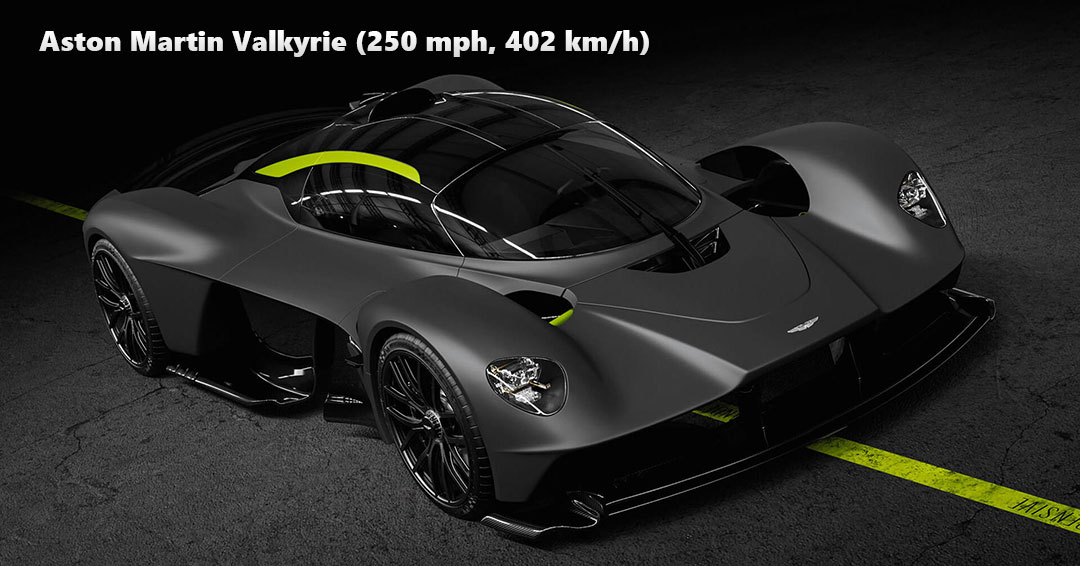
The Valkyrie is a track-focused hypercar with formidable aerodynamics and a naturally aspirated V12 engine that emphasizes performance according to limited road test data. The engine features a total power output of 1,160 hp (865 kW; 1,176 PS), forefronting agility and responsiveness. Consequently, driving comfort isn’t a priority; the model’s seating is akin to Formula One race cars, being narrow and confining. However, this is a side note compared to the overall capability of the 2022 model—providing a driving experience that fuses power, agility, and aerodynamic finesse, and mirrors the varying intensities of the very same Formula One cars.
17. Tesla Roadster (250 mph, 402 km/h)
The second-generation Tesla Roadster is an all-electric hypercar with a top speed of 250 mph (402 km/h) or more. The first generation of the model boasted a peak of 125 mph (201 km/h), highlighting the strides made in Tesla’s acceleration and electric powertrain technology with the second iteration. This hypercar additionally achieves 0-60 mph (approximately 97 km/h) in 1.9 seconds which is faster than the original Roadster.
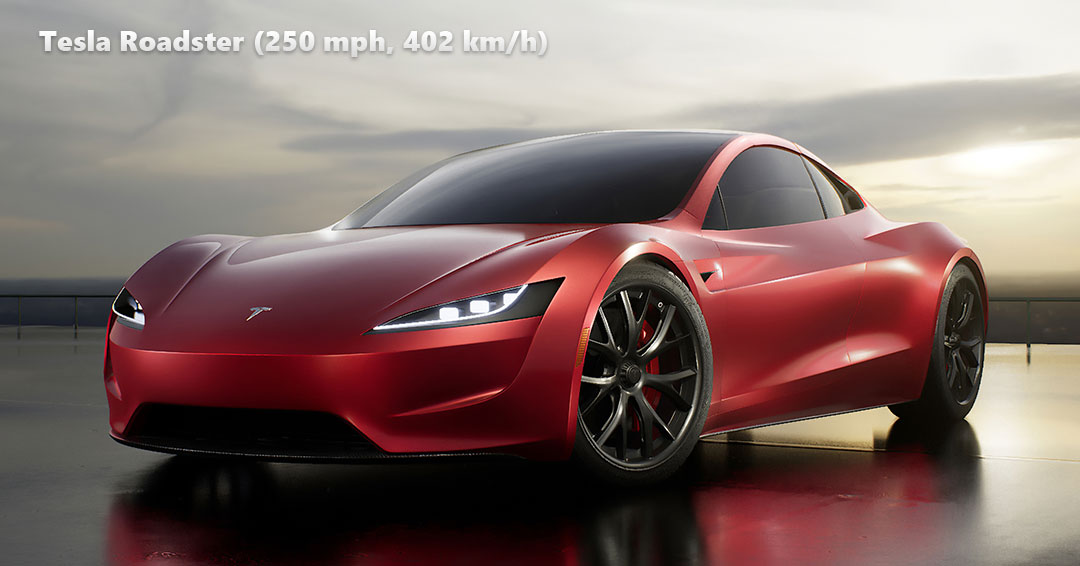
Tesla’s second-generation model surpasses its predecessor in myriad ways, featuring a removable glass roof, an impressive electric range of 620 miles (1,000 kilometers), and four seats which is a rarity among hypercars. The Roadster embodies Tesla’s vision of high-performance driving through an advanced powertrain and multiple electric motors that pave the way for electric sports vehicles.
18. Koenigsegg Gemera (249 mph, 400 km/h)
The Koenigsegg Gemera is a four-seat hybrid hypercar with an estimated top speed of 249 mph (400 km/h). The Gemera’s design merges performance and practicality, allowing for a secondary top speed of 300 km/h (186 mph) in electric mode and a 0 to 100 km/h (62 mph) acceleration of approximately 1.9 seconds.

A computer-controlled system modulates the Gemera’s driving experience. This in turn enhances capability and minimizes fuel consumption according to changing circumstances. Meanwhile, the Gemera’s twin-turbocharged 2.0L 3-cylinder engine, complemented by electric motors, forms a hybrid powertrain. This combination delivers swiftness while prioritizing the comfort of its occupants during high-speed endeavors, setting it apart in the hypercar landscape.
19. Deus Vayanne (249 mph, 400 km/h)
The Deus Vayanne is an Austrian 2025 all-electric sports car designed to achieve a top speed of 249 mph (400 km/h). DEUS Automobiles reports that acceleration time falls around 1.99 seconds when speeding up from 0 to 100 km/h (62 mph). There’s limited information about its road tests, but the Vayanne’s manufacturer emphasizes practical usage alongside the car’s high power.
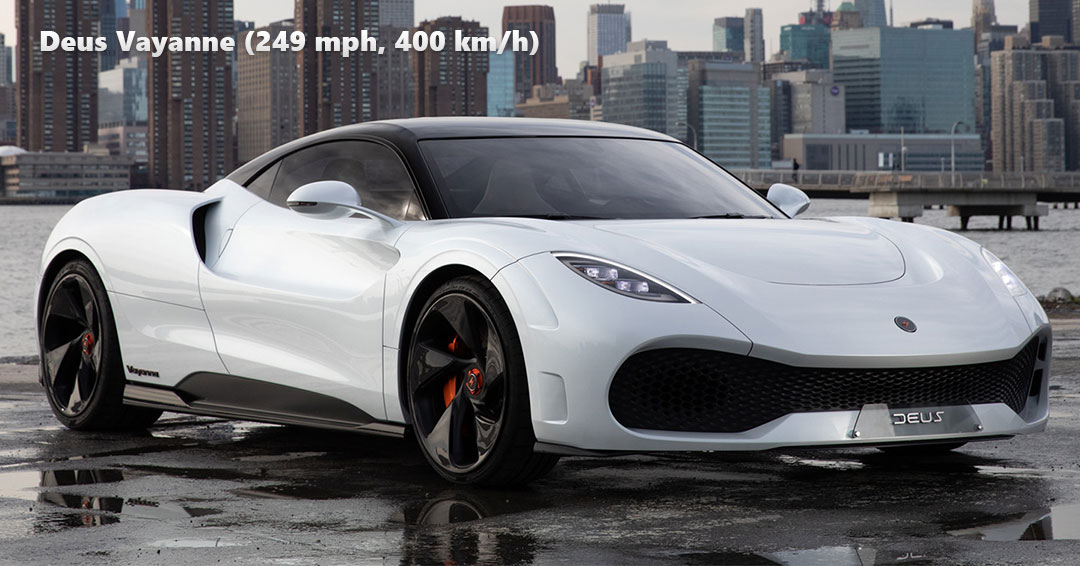
Practicality is reflected in the driving experience of the Vayanne, with additions such as combined digital and analog utilities, a spacious interior, streamlined storage space, and an ergonomic command experience of driving functions enhancing usability. Fuel consumption isn’t a concern as the car is all-electric with a power output of 2250 hp and an 80% SOC (state of charge), underscoring the Vayanne’s efficiency as a high-speed vehicle.
20. Pagani Huayra (238 mph, 383 km/h)
The Pagani Huayra is an acclaimed Italian sports car with a top speed of 238 mph (383 km/h) and an acceleration of 0-100 km/h (62mph) in 3.3 seconds. It was introduced in 2011 and won the Top Gear’s Hypercar of the Year award the following year due to its prowess. Pagani’s Huayra delivers an agility-centered driving experience through its twin-turbocharged V12 engine and 1.66 g of lateral acceleration.
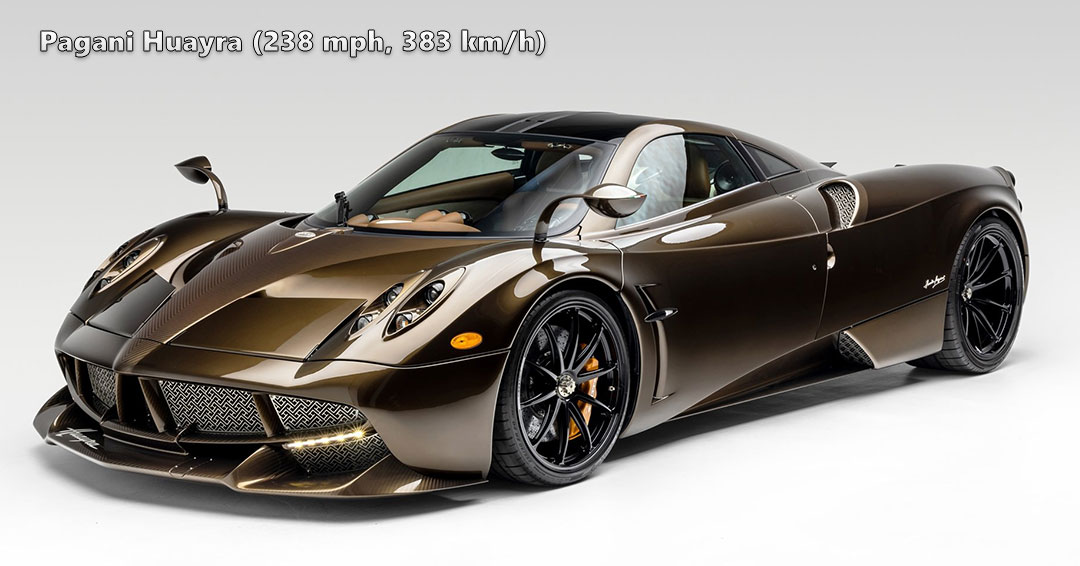
The Huayra’s driving experience is enhanced by active and nimble aerodynamics, allowing modifications for optimal performance as those in the front seat push the Huayra model to its peak. Engine efficiency is another key feature, reducing turbo lag and boosting responsiveness. The interior is designed for two passengers, and is meticulous and lavish, emphasizing comfort. Meanwhile, the fuel consumption rate stands at 20.5 liters per 100km, which is around 11.5 US mpg. The Mercedes-AMG M158 twin-turbo V12 engine underscores the Huayra’s commitment to high-speed performance and responsiveness. Additionally, the Pagani Huayra’s success has spawned several variants, including the Huayra Codalunga.
21. Bugatti Centodieci (236 mph, 380 km/h)
The Bugatti Centodieci is another top-of-line, limited-edition hypercar from Bugatti with a top speed of 236 mph (380 km/h). Centodieci’s design is a homage to the Bugatti EB110, which was discontinued in 1995. Acceleration of 0 to 100 km/h (62 mph) comes in at 2.4 seconds, similar to the Bugatti Super Sport and Super Sport 300+. Other similar features include a quad-turbocharged 8.0L W16 engine and a combined fuel consumption rate of 21.47 liters per 100 km (approximately 11 mpg).
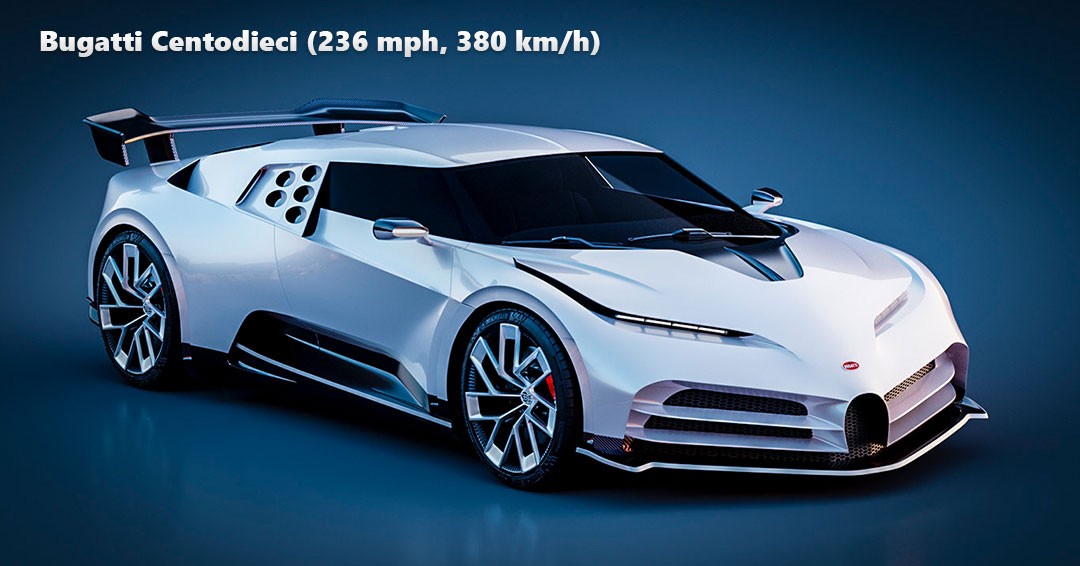
The Bugatti Centodieci remains distinct from the other models because of its exclusive limited production, with only ten units being manufactured. Each of the ten models is rigorously tested, ensuring the safety and stability of the car under intense conditions as well as the comfort of the driver in Bugatti’s bespoke interior.
22. Bugatti Divo (236 mph, 380 km/h)
The Bugatti Divo is a track-focused car that demonstrates a top speed of 236 mph (380 km/h). The car prioritizes aerodynamics, agility, and handling prowess which is enhanced by an acceleration rate of 0 to 100 km/h (62 mph) in 2.7 seconds. Driving comfort, security, and efficiency are ensured by its steering and the car’s responsiveness, even at low speeds, making it a flexible selection among the fastest cars.

The Divo bares an 8.0L W16 engine, similar to other Bugatti models. Fuel consumption rests at 22.3 liters per 100 kilometers which converts to 10.54 U.S. mpg, unlike other models. Additionally, the Divo is lighter than the standard Bugatti Chiron due to implementations such as carbon-fiber components and reduced sound insulation. As a result, the model is eight seconds faster than the Chiron.
23. Pagani Zonda R (233 mph, 375 km/h)
The Pagani Zonda R is a track-focused hypercar with a limited production line and a top speed of 233 mph (375 km/h). The Zonda R’s engine is a 6.0 L Mercedes-Benz M120 V12 with a modified power output, providing substantial grip and feasible limits for lateral acceleration.
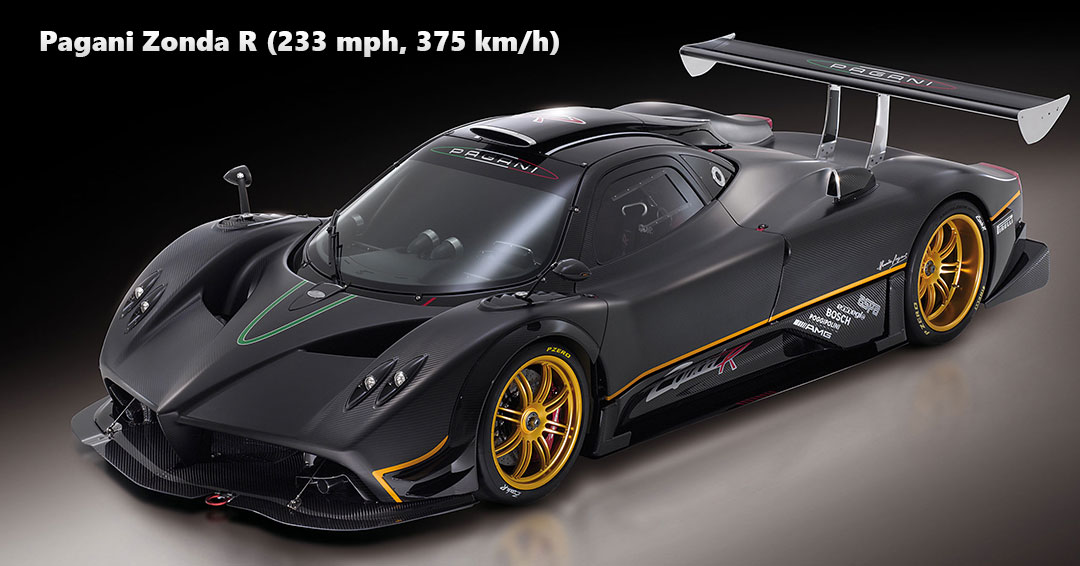
Adding to efficiency and agility of the Zonda R is a six-speed XTRAC sequential dog gearbox and automatic clutch, enabling rapid gearshifts in just 20 milliseconds. Other features such as the interior and driving comfort are downplayed to bolster performance, though its few purchasers are able to make modifications as needed. Fuel consumption is not disclosed, but a 0-100 km/h (0-62 mph) acceleration of 2.8 seconds underscores its engineering.
24. Pagani Huayra Codalunga (230 mph, 370 km/h)
The Pagani Huayra Codalunga is a 2022 variant of the successful Pagani Huayra and features a top speed of 230 mph (370 km/h). The variant is limited to five units as an exclusive tribute to 1960s race cars. Its twin-turbo V12 engine generates 840 CV (618 kW) at 5,900 RPM to deliver a maximum of 840 horsepower as a nod to the classic race car era. Adding to its capabilities is an acceleration rate of 2.7 seconds across 0 to 100 km/h (62mph), melding both top-speed prowess and quick-fire approach.

The Pagani Huayra Codalunga was conceived as a project by Pagani Grandi Complicazioni and, due to its exclusivity, blends design and performance. It achieves a longer and smoother profile than its predecessor, racing to similar heights.
25. Gordon Murray T.50 (226 mph, 364 km/h)
The Gordon Murray T.50 is a hypercar and spiritual successor to the McLaren F1 featuring a top speed of 226 mph (364 km/h). The T.50 is distinct amongst the fastest cars because of its designer, renowned engineer Gordon Murray, who conceptualized the McLaren F1 and conceived the GMA T.50 as a successor capable of overcoming the former’s technological limitations.
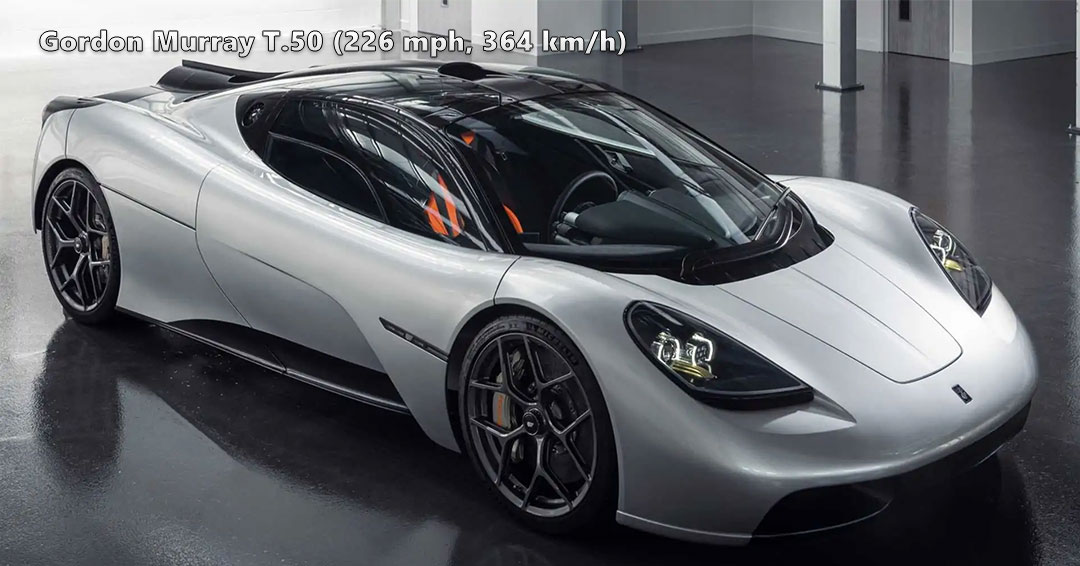
Limited road test data about the T.50 focuses on agility, emphasizing its handling and lightweight design. Driving safety, efficiency, and comfort are additionally insured by the hypercar’s minimalistic interior, streamlined controls, and a prominent analog tachometer—allowing the driver to zero in on high performance as they accelerate from 0 to 100 km/h (62 mph) in approximately 2.5 seconds. Another nod to the vehicle’s agility is its high-revving V12 engine. It produces 656 hp and 344 lb-ft of torque at 9,000 rpm, enhancing agility alongside immersive engine sound through the Direct Path Induction Sound feature.
26. Pininfarina Battista (222 mph, 357 km/h)
The Pininfarina Battista is an all-electric hypercar demonstrating a top speed of 222 mph (357 km/h). The car’s engineering is a marriage of agility and performance, featuring advanced electric powertrain technology that achieves a 0-100 km/h acceleration rate in 1.86 seconds alongside its top speed.
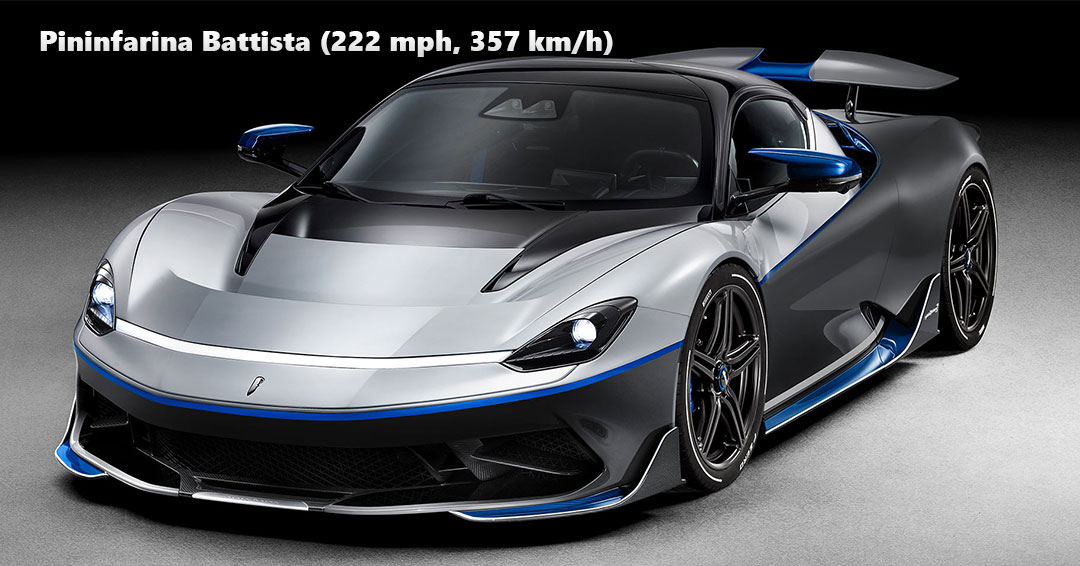
Road test data highlights the Battista’s electric performance and emphasizes adjustable suspension for road comfort alongside five driving modes to modulate power output. Furthermore, the Battista is equipped with carbon ceramic brake discs and an active rear wing for improved stopping power, showcasing a commitment to both speed and safety. Meanwhile, its advanced electric powertrain features four electric motors to underline Pininfarina’s high-performance capabilities.
27. Lamborghini Sian FKP 37 (221 mph, 356 km/h)
The Lamborghini Sian FKP 37 is a hybrid hypercar featuring a top speed of 221 mph (356 km/h). The Sián is the first of Lamborghini’s hybrid production cars, debuting with an aerodynamic design and a robust V12 engine that prioritizes speed.

Lambo’s hypercar capitalizes on a lithium-ion supercapacitor, which excels in power-to-weight ratio, and a 48V system that enables high peak currents. An acceleration of 0 to 100 km/h is managed in 2.8 seconds while agility pairs with driving efficiency through the fuel consumption rate of 19.2 liters per 100 kilometers or 12.3 U.S. miles per gallon. A complete carbon body and twelve cylinders further complement the hypercar’s design, serving as one of the prime examples of cutting-edge engineering and speed in the realm of hybrid hypercars.
28. De Tomaso P72 (221 mph, 356 km/h)
The De Tomaso P72 is an Italian sports car with a high-performance V8 engine and an estimated top speed of 221 mph (356 km/h). The De Tomaso P72’s futuristic design is an homage to the short-lived P70 by the same manufacturers. Consequently, the P72 is inspired by racing cars, which is further evidenced by its top speed and acceleration of 0 to 100 km/h in 2.0 seconds.
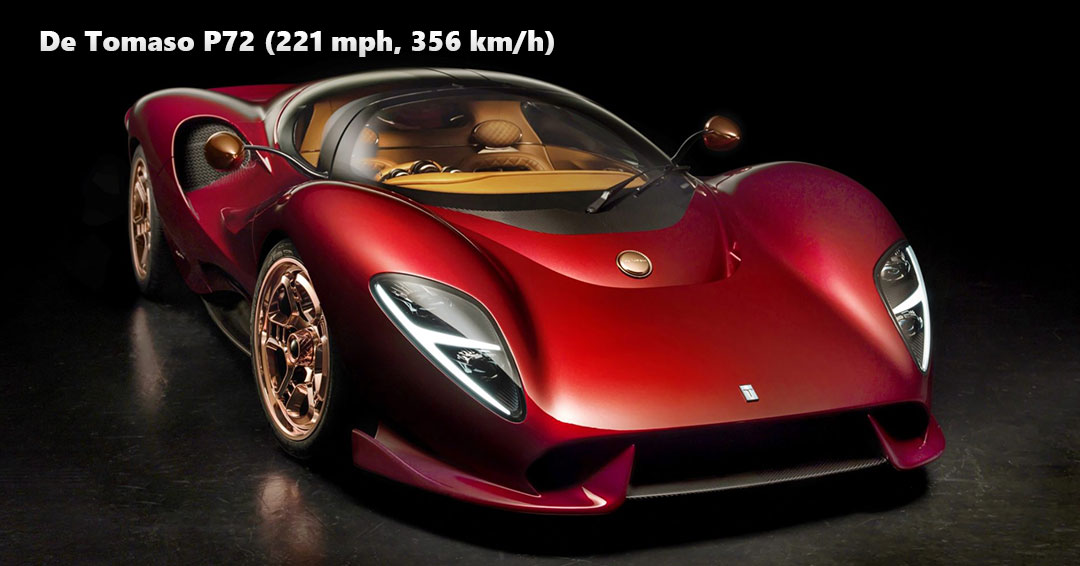
The scope of the P72 lies in its exclusive build, including copper-clad instruments and quilted leather seats for driving comfort. These attributes blend into the improved airflow and noise reduction so that the few people lucky enough to test out the Ford Coyote V8 engine are completely immersed in an experience akin to the classic P70 under a modern, more efficient shell.
29. Lamborghini Countach (221 mph, 356 km/h)
The Lamborghini Countach is a historic hypercar that was revived in 2021 as the Countach LPI 800-4 with a top speed of 221 mph (356 km/h). The original Countach was produced from 1974 until 1990; its modern iteration honors the legacy of its predecessor by mixing nostalgia with contemporary prowess and electric-hybrid capabilities.

The Countach LPI 800-4 is capable of an acceleration of 0 to 100 km/h in 2.8 seconds. This is backed by an electrically assisted 6.5-liter V-12 and engineering elements inspired by the manufacturer’s Sián and Aventador. The former is the basis of the modern Countach’s ability whereas its driving experience is akin to the Aventador. Even so, the 2022 model is a faithful rendition—embodying its forefather’s exterior but with a modernized interior for enhanced driving comfort as well as aerodynamics to maximize swiftness and engineering to enhance overall performance across speeds.
30. Lamborghini Aventador LP780-4 Ultimae (220 mph, 354 km/h)
The Lamborghini Aventador LP780-4 Ultimae is a high-performance iteration of the Aventador that demonstrates a top speed of 220 mph (354 km/h). The Ultimae marks the last Lamborghini V-12-powered supercar and does so by emphasizing agility. Its naturally aspirated V12 engine boasts 780 CV (574 kW) at 8,500 rpm coupled with an 0 to 100 km/h (62 mph) acceleration rate of 2.8 seconds.
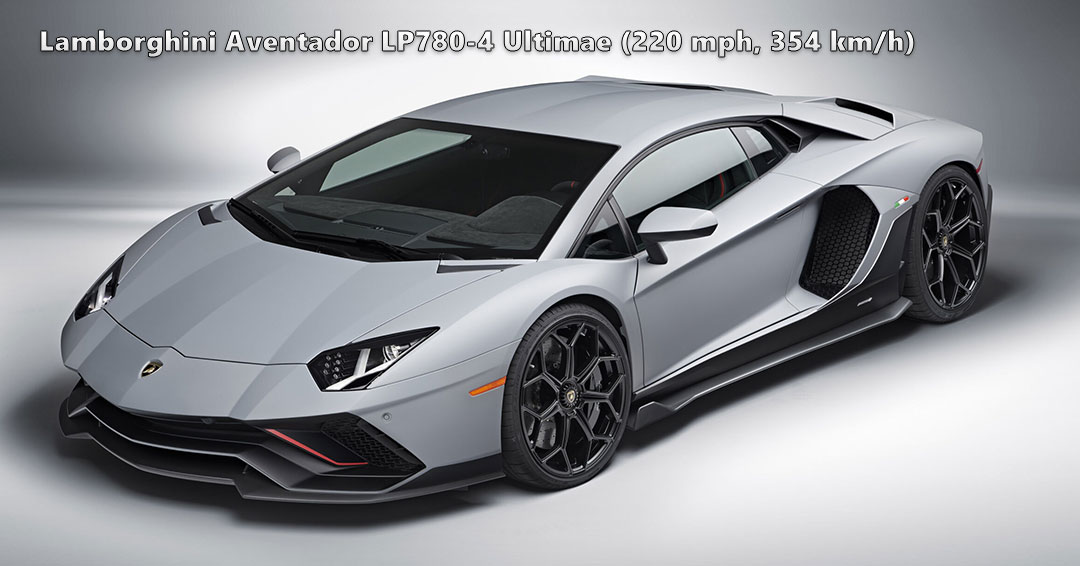
The Ultimae integrates new visuals and interior tweaks, ensuring a bold and powerful presence on the road. Furthermore, drivers familiar with other models in the Aventador line, namely the Aventador S and SVJ, will gain the same standard features, heightened responsiveness, and a fuel consumption rate of 18 liters per 100 kilometers. (13.1 U.S. mpg).
31. Mercedes-AMG One (219 mph, 352 km/h)
The Mercedes-AMG One is a dynamic hybrid hypercar that nets a top speed of 219 mph (352 km/h). The AMG One affords its speed through innovations from Formula One technology as well as a high-revving V6 engine paired with electric assistance. Additionally, the model accelerates from 0-100 km/h in 2.9 seconds.
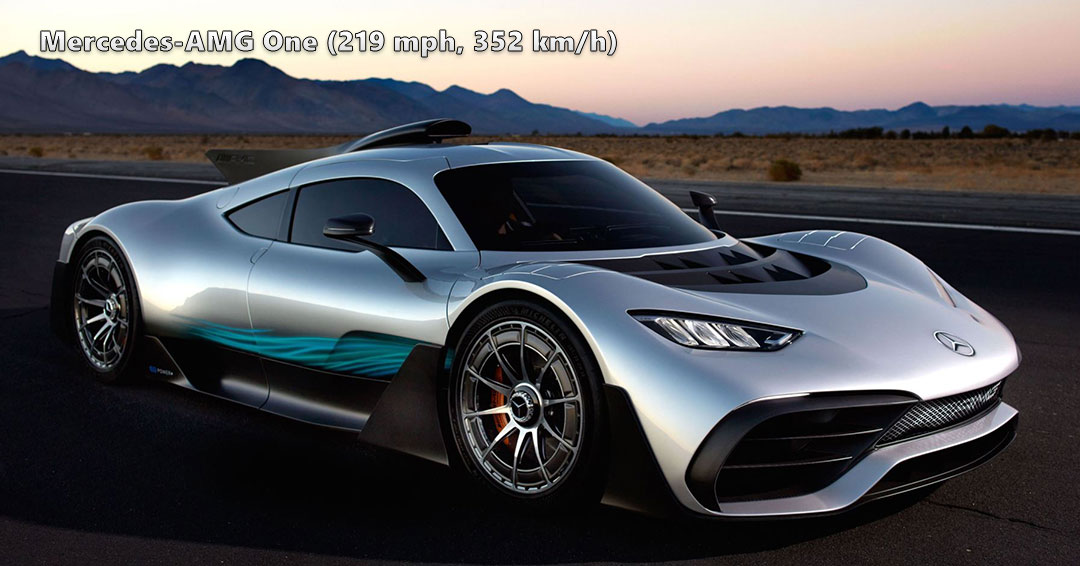
Dynamic driving modes accentuate the AMG One’s capabilities, further underscoring the prospect of its Formula One-inspired performance. These modes include Race Safe with an all-electric start, Strat 2 with greater suspension tuning and full electric power, EV for all-electric driving, and Race Plus which provides active aerodynamics. The remaining two modes, Race and Individual, refer to a charging feature and designated personalization, respectively. The AMG One seamlessly transitions between these performance profiles, providing buyers with both top speed and a sense of efficiency backed by a fuel consumption rate of 8.7 liters per 100 km.
32. Lotus Evija (218 mph, 350 km/h)
The Lotus Evija is an all-electric hypercar demonstrating an estimated top speed of 218 mph (350 km/h). The Evija is notable among our list because it is the Lotus Group’s first high-performance electric sports car. It boasts a rapid acceleration from 0 to 100 km/h (62 mph) in under 3 seconds, highlighting the capabilities of electric performance.

The Evija is capable of sustaining uninterrupted flat-out driving for at least seven minutes whilst in Track mode. Efficiency further backs the car’s top speeds through a fast-charging battery that intakes an 800kW charge, advanced aerodynamics, and four-radiator cooling—ensuring that customers experience the most of this high-performing all-electric hypercar. The Evija additionally features a drivetrain that Lotus Cars claims to be among the world’s most potent with the powertrain as a whole incorporating four advanced and swift electric motors.
33. McLaren P1 (217 mph, 349 km/h)
The McLaren P1 is a hybrid sports car that demonstrates a top speed of 217 mph (349 km/h) and a reputation for exalted aerodynamic design and high-performance capabilities. It is the successor to the McLaren F1, a similarly famous hypercar and one of the fastest production cars of its time.

The P1 boasts a hybrid powertrain featuring a twin-turbocharged V8 engine, enhanced by electric assistance. It’s able to achieve both its top speed and an acceleration rate of 0 to 100 km/h in approximately 2.8 seconds due to its V8 powertrain. Positive road test results underline its handling, rapid acceleration, and overall performance. The P1 additionally prioritizes driver engagement and comfort despite its high-speed prowess. Meanwhile, the fuel consumption rate is noted at 8.3 l/100km (2.83 US mpg), adding an efficiency aspect to its capabilities.
34. Ferrari Enzo (217 mph, 349 km/h)
The Ferrari Enzo is a limited-production supercar with a top speed capped at 217 mph (349 km/h). The car is an homage to the company’s founder, Enzo Ferrari, and exhibits an aerodynamic design paired with a high-performance V12 engine.
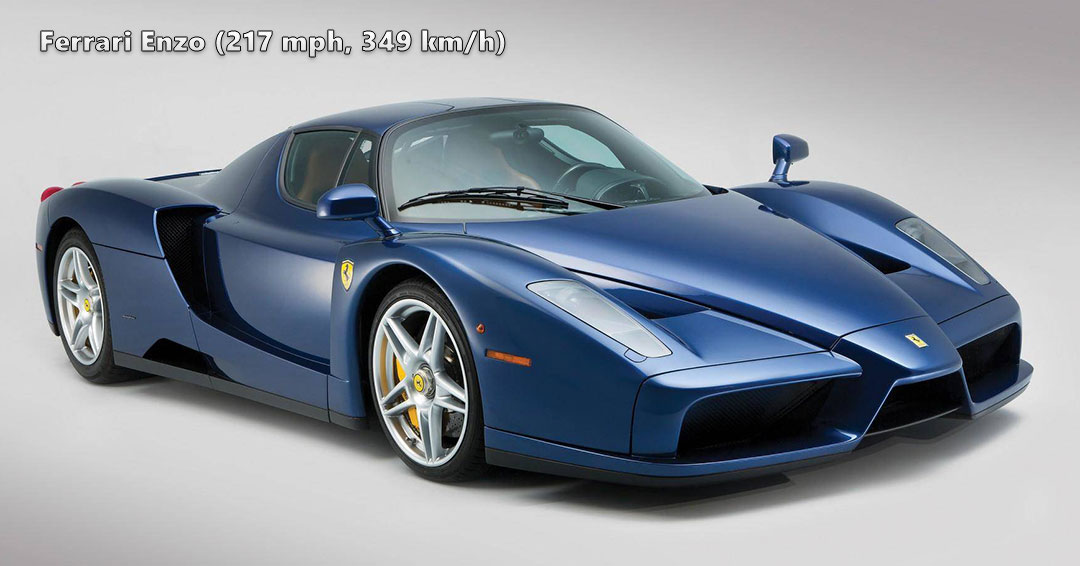
The Enzo demonstrates agility and responsiveness with its non-electrically-assisted V12 engine (the last Ferrari hypercar to do so without forced induction) as well as an acceleration rate of 0 to 100 km/h in approximately 3.1 seconds. Positive road test results commend the car’s handling and overall performance, utilizing aerodynamics to generate downforce without relying on large rear spoilers. The Enzo additionally achieves a fuel consumption rate of 23 l/100 km (10.23 US mpg), coupling speed with performance to enhance the overall driving experience.
What are the body types of the fastest cars?
The body types of the fastest cars are largely two-door coupes with some variations. Two-door coupes are the optimal car body style for hypercars like the Koenigsegg Jesko Absolut or Bugatti Bolide because of their aerodynamic efficiency and streamlined design. The reduced number of doors minimizes the overall weight of the vehicle and allows for a downsized silhouette. This does not necessarily accommodate drivers of all sizes but reduces air resistance and enables higher speeds.
Due to these factors, none of the fastest cars we’ve recorded are sedans. Sedans don’t align with the performance-oriented objectives of hypercars as they prioritize passenger capacity and comfort over aerodynamics and weight reduction. That said, there are variations to the coupe focus of sports cars. For instance, the Koenigsegg Agera has a Targa top body style which is a roof design that blends the coupe and a convertible. Meanwhile, the Bugatti Mistral is a full-fledged convertible whereas vehicles like the Tesla Roadster are a 2+2 coupe, featuring two doors but four seats. These variations offer more selection but generally remain in the confines of the coupe body style to achieve peak speed.
What are the fastest SUVs?
Below is a list of the fastest SUV models according to their top speed.
- Aston Martin DBX707: The Aston Martin DBX707 achieves a top speed of 193 mph (311 km/h) and is priced at $240,000 and above. It has a weight of 5,128 lb and is powered by a 4.0 L M177 twin-turbocharged V8 engine.
- Ferrari Purosangue: The Italian Ferrari Purosangue shares a top speed of 193 mph (311 km/h) with the DBX707 and features a formidable 6.5 L V12 petrol engine. Prices generally start at $400,000 with curb weight amounting to 4,850 lb.
- Lamborghini Urus: The Lamborghini Urus is one of the fastest SUVs on the market, reaching a top speed of 190 mph (306 km/h). It is priced at $240,000 and above, weighs 4,986 lb, and is equipped with a 4.0 L FSI twin-turbo V8 engine. The Lamborghini Performante, a special variant, matches the top speed of the standard Urus.
- Audi RS Q8: The Audi RS Q8 achieves a top speed of 190 mph (306 km/h) as one of the swiftest SUV models. Prices generally start at $125,000 and above. Meanwhile, the car’s weight comes in at 5,503 lb and is powered by a 4.0 TFSI engine.
- Porsche Cayenne Coupe Turbo GT: The Porsche Cayenne Coupe Turbo GT boasts a top speed of 189 mph (304 km/h) with a price tag of $150,000 and above. The weight of this model ranges from 4,900 to 5,100 lb, delivering a dynamic driving experience.
The SUV models listed above demonstrate impressive top speeds for otherwise heavy vehicles. The Aston Martin DBX707 and Ferrari Purosangue share an exceptional top speed of 193 mph. The DBX707 is priced at $240,000 and above and weighs 5,128 lb, but the Purosangue comes at a higher starting price of $400,000, featuring a potent 6.5 L V12 petrol engine and a curb weight of 4,850 lb. The Lamborghini Urus, a standout in speed, reaches 190 mph and is priced similarly to the DBX707. The Audi RS Q8 matches the Urus in top speed and comes with a more accessible starting price of $125,000. Meanwhile, the Porsche Cayenne Coupe Turbo GT offers a dynamic driving experience with a slower but impressive top speed of 189 mph for 4900 to 5100 lbs of weight.
What are the fastest trucks?
Below is a list of the fastest pickup trucks according to their top speeds.
- 2004 Dodge Ram SRT-10: The 2004 Dodge Ram SRT-10 achieves a top speed of 154 mph (248 km/h). It is no longer in production, with prices ranging from as low as $24,000 to as high as $76,000. The car weighs 5,130 lb (2,327 kg) and is powered by an 8.3 L V10 engine.
- 2014 GMC Sierra 1500: The 2014 GMC Sierra 1500 reaches a top speed of 150 mph (241 km/h), weighs 5,197 lbs (2,354 kg), and features a 4.3-liter V6 engine. Although no longer in production, prices generally vary from $11,000 to $36,000.
- 2004 SVT F-150 Lightning: The 2004 SVT F-150 Lightning attains a top speed of 148 mph (238 km/h), with a price range of ?$25,000 to $70,000 or more. Weighing 4,670 lbs (2,117 kg), it is equipped with a 90-degree, SOHC Supercharged Triton V-8 engine.
- Hennessey Mammoth 1000 TRX: The Hennessey Mammoth 1000 TRX exhibits a top speed of 130 mph (209 km/h), priced at $150,000 and above, with a weight of 6,865.195 pounds (3,113 kg). It is driven by an upgraded 6.2-liter supercharged Hellcat V8 engine.
- 2021 Ram 1500 TRX: The 2021 Ram 1500 TRX has a top speed of 118 mph (190 km/h) and is priced at $72,120 and above. The truck features a weight of 6,396 lbs (2,902 kg) and is powered by a supercharged, intercooled pushrod 16-valve V-8 engine.
The pick-up trucks listed above offer a range of options. Dodge’s Ram SRT-10 stands out in terms of top speed, achieving 154 mph and showcasing unparalleled performance despite being an older model. Meanwhile, the 2021 Ram 1500 is distinct due to its potent engine, a 16-valve V-8 engine, which is both newer and able to reach a slower but no less impressive 118 mph at top speed. The 2004 SVT F-150 Lightning is older but quicker with a more affordable price tag. On the other hand, the 2014 GMC Sierra 1500 presents a notable and affordable option, with prices ranging from $11,000 to $36,000 whereas the Hennessey Mammoth 1000 TRX is heavier and more expensive but speedy with an upgraded engine to support its agility.
What are the fastest electric cars?
Below is a list of the fastest electric cars according to their top speeds.
- Rimac Nevera: The Rimac Nevera boasts a top speed of 258 mph (415 km/h) and is priced at $2 million and above. This hypercar is additionally powered by four liquid-cooled permanent magnet synchronous electric motors and carries a weight of 5,100 lb (2,313 kg).
- Tesla Roadster: The second-generation Tesla Roadster achieves a top speed of 250 mph (402 km/h) with a price tag of $200,000 and above. The electric vehicle weighs 1,836 lbs (833 kg) and is equipped with three electric motors—one in the front and two in the rear.
- Deus Vayanne: The Deus Vayanne is priced at $2 million and above and exhibits a top speed of 250 mph (402 km/h). The agility of the vehicle is paired with a weight of 3,990 lbs (1,812 kg) and a potent powertrain.
- Pininfarina Battista: The Pininfarina Battista demonstrates a top speed of 222 mph (357 km/h) and a weight of 4,550 lb (2,068 kg). Its power is derived from a 120 kW·h battery pack, highlighting advanced electric propulsion technology. Prices generally begin at $2.2 million and above.
- Lotus Evija: The Lotus Evija’s price tag starts at $2 million and showcases a top speed of 218 mph (350 km/h). It further distinguishes itself with four electric motors strategically placed at each wheel and a weight of 4,160 lb (1,889 kg),
The electric cars described above present a spectrum of performances. The Rimac Nevera is the most impressive due to its top speed of 258 mph and advanced electric motor technology. Deus Vayanne follows behind with a top speed of 250 mph which is overshadowed by the Tesla Roadster and its lighter body of only 1,836 lbs at curb weight. The latter is additionally the most affordable option on this list with a starting price of $200,000, offering a balance of performance and cost. Meanwhile, the Pininfarina Battista and Lotus Evija offer both luxury and advanced electric propulsion power for a top speed of 222 and 217 mph, respectively.
Are fuel-based cars faster than electric cars?
Fuel-based cars are generally faster than electric cars when it comes to their top speed. Fuel-based cars like the Koenigsegg Jesko Absolut or Bugatti Bolide have the potential to reach peaks as high as 330 mph or 311 mph, respectively. Meanwhile, the fastest electric cars we’ve explored include the Rimac Nevera and Deus Vayanne which respectively claim top speeds at 258 mph and 250 mph. On the other hand, electric cars win the electric car versus gas car debate when it comes to exceptional acceleration times due to their electric motors and torque capabilities. The Rimac Nevera reaches 0 to 100 km/h (62 mph) in only 1.82 seconds while Deus Vayanne achieves the same distance in just under 2 seconds. The Koenigsegg Jesko Absolut, one of the fastest cars in the world, only accelerates from 0 to 100 km/h in 2.5 seconds while the Bugatti Bolide achieves a notably quicker distance in 2.2 seconds. This indicates that fuel-based cars have faster top speeds while electric cars have quicker acceleration times.
